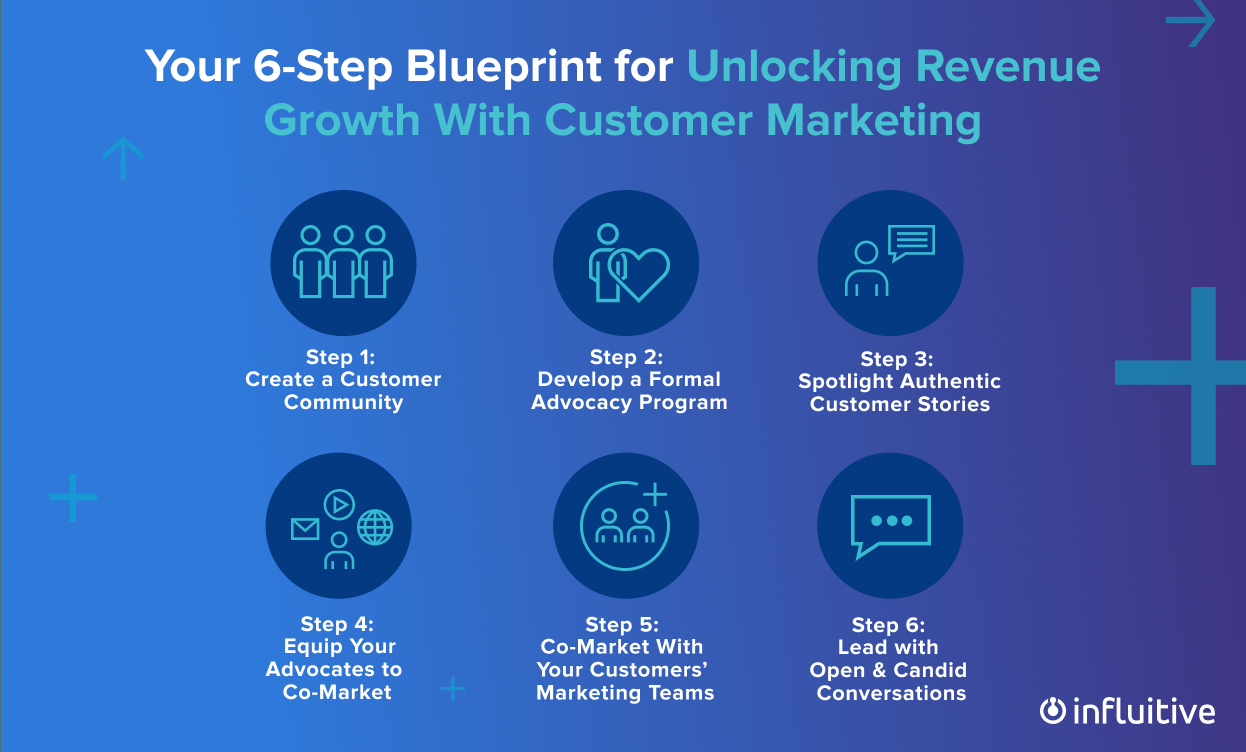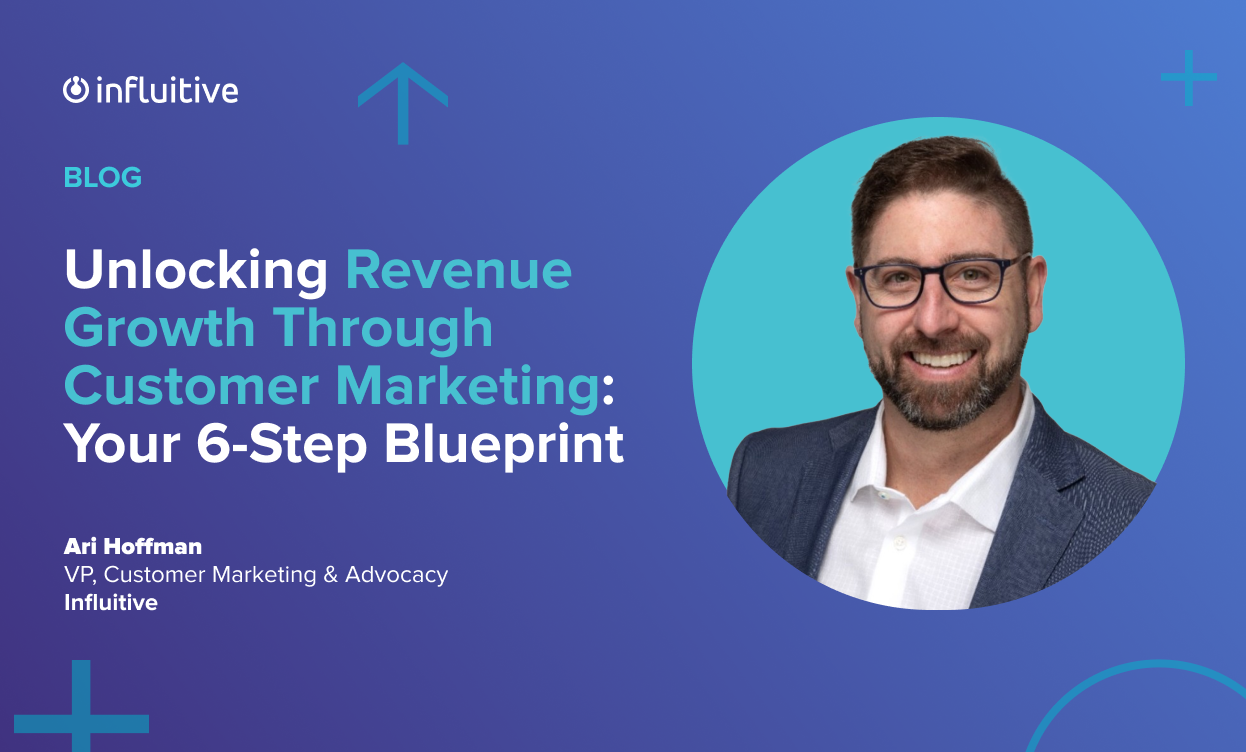Many companies today underestimate the immense revenue potential sitting right below the surface – their ability to dramatically expand within their existing customer base. Post-COVID, forward-thinking brands are now waking up to the profitability their bases represent by realigning revenue growth strategies around customer marketing motions.
Yet despite its potential, customer marketing remains underinvested. Marketing resources often concentrate on acquisition tactics that target a much smaller revenue pool and this mismatch leaves money on the table.
In this blog, I’ll share a 6-step blueprint to help you optimize your customer marketing approach to maximize revenue from your hard-won customer base.
Below is a cheat sheet for this approach, for a deeper dive read: “5 Ways Marketing Leaders Can Recession-Proof Their Teams and Programs.”
Step 1: Construct a Customer Community
Your ideal customers likely already congregate in various corners of the web to discuss your industry. By building an owned online community, you’re giving them a dedicated home to connect with your brand and each other.
A thriving community that adds value becomes a hub that members actively participate in. This cultivates a strong sense of belonging and brand affinity.
Here are some elements to incorporate into your community platform:
- Discussion forums to ask questions, share best practices, and engage in dialogue. Segment by interest, product area, or member types.
- Content libraries with access to resources, training, and materials. Keep members informed and educated.
- Networking opportunities through chat, groups, live events, and mentorship programs. Enable members to interact in real time.
- Profile pages for members to share backgrounds and contact info. Helps build relationships.
- Gamification features like points, badges, and leaderboards. Adds fun and motivation. Advocacy toolkits to make promoting your brand turnkey. Includes assets like social post templates, reference pools, and referral programs.
- Tiered membership levels that add perks based on activity and commitment. Reward your VIPs. You can add tangible rewards depending on your budget or services and product if you’re working with fewer resources.
- Branded community name, guidelines, imagery and other elements to immerse members in your world.
Pro Tip: Collect feedback from highly engaged customers to find out what they’d like to see in their community to tailor-fit the experience for your audience. Do the same with your less engaged to see what might spark their interest.
Your community platform becomes a hub that members organically gravitate to. This concentrates valuable engagement and data in one owned destination you fully control.
Step 2: Develop a Formal Advocacy Program
Most satisfied customers won’t automatically advocate without motivation (some will, but it’s a much smaller pool from the potential pull you have across your entire install base). A structured advocacy program provides the framework to systematically recruit and activate brand promoters.
These programs guide members through different tiers of involvement based on their level of commitment. Participants complete various challenges and activities to earn rewards and recognition.
Popular options include:
- Writing product reviews on business directories like G2 and TrustRadius
- Creating social posts and videos showcasing use cases
- Referring contacts to sales teams for demos
- Case study participation detailing implementation success
- Serving as references and providing testimonials
- Contributing guest blog articles or co-marketing campaigns
- Mentoring other members through forums and community Q&A
- Attending or speaking at company events and webinars
- Offering product feedback and ideas directly to product teams
Pro Tip: Make sure to understand your promoters’ motivations. Are they looking to build their personal brand, network, become subject matter experts, or collect valuable rewards? Then, gear your programs to highlight those benefits.
These programs often grant points for each completed activity which unlock exclusive perks and merch. High performers get highlighted in promotions and inner circle groups.
This structured engagement ladder gamifies the experience while allowing customers to self-select their involvement based on interests and availability. That means customers start to raise their hands proactively rather than your teams having to expend copious amounts of effort manually searching for the right fit.
Step 3: Spotlight Authentic Customer Stories
We all know our prospects and customers would rather hear from our users than our sales team, at least to capture their initial attention. Nothing is stronger than word-of-mouth referrals and references accept for prior use with your product.
User-generated content that comes directly from customers packs a uniquely convincing punch. Their authentic perspectives counter slick marketing speak and engage audiences on a personal level.
To capture this, guide customers through telling their real experiences in their own voice:
- Interview customers 1:1 virtually or in person rather than through automated surveys so they can speak freely rather than sticking to a rigid script
- Ask strategic questions that extract their journey, challenges overcome, a-ha moments, and results achieved (more on that in Step 6)
- Have members participate in video and written testimonials that highlight their emotions and personality
- Limit heavy editing that strips away rawness and filters out brand mentions to keep their personal tone intact
- Leverage AI to repurpose content across platforms like site pages, social posts, sales collateral, emails, blogs, and ads to multiply reach
- Give members veto power on how their stories get used to maintain trust. Some may wish to remain private
- Feature user-generated visuals from members like product screenshots, team photos, and infographics for added authenticity
Pro Tip: Make your customer, not your product, the hero of the story and let your company ride their magnificent coattails into the promise land.
By regularly capturing and disseminating customer perspectives, you infuse marketing with transparency and sincerity. This breaks dependence on overly polished content.
Step 4: Equip Advocates to Co-Market With You
You’ve nurtured a community and program. Now make it simple for members to spread the word. Arm them with resources that make advocating painless.
A few ideas to consider:
- Social media toolkits with pre-written tweets, images, hashtags, and instructions to amplify reach
- Review templates and quick product overviews to help them write compelling reviews
- Email copy, banners, and tools to contact peers with referral offers
- Co-branded assets like presentations, eBooks, and case studies to co-promote
- Links and instructions to easily share your content on their platforms
- Digital badges and signatures for email and social bios
Pro Tip: Make this easy and automated for your customers by leveraging tools that allow your customers to share with the click of a mouse rather than redirecting them to multiple different destinations.
Having these assets readily accessible lets members advocate for you on their own initiative and reduces any friction surrounding participation.
Step 5: Engage Your Customers’ Marketing Teams as Co-Marketers
Integrate your customers into key marketing initiatives as partners rather than just treating them like passive consumers. To take this a step further though, consider how you can partner with the customer marketing teams behind your customers. You’ll maximize your reach and impact by merging your brand’s audience with your customers’ company network and spheres of influence.
Ask to make the connection and then find out what opportunities your customers’ marketing teams are interested in so you can help co-promote mutual activities and better align your team objectives.
Here are a few ways you can collaborate:
- Co-create content like eBooks, blog posts, guides, and videos based on their interests and perspectives
- Ask if they’d like to write a guest post on your company blog to reach a wider audience
- Repurpose their social content by resharing it on your own social channels to expand visibility and let them know you’re there to support their objectives
Pro Tip: Your customers’ Legal and Comms teams can often get in the way of a wonderful case study or testimonial, denying key statistics mentioned or the entire piece altogether. By helping them market to their community, you can build rapport and trust allowing for greater flexibility in your content.
It’s also important to build permission into your legal terms to use customer-generated content in future marketing efforts.
Step 6: Lead with Open, Candid Customer Conversations
Finally, regularly connect 1:1 with customers through open conversations. Ask thoughtful questions to uncover pain points, desires, and your brand’s role in their world. Then listen intently.
These insights will prove invaluable in developing products, messaging, content and experiences that truly resonate. Keep your finger on the pulse through regular check-ins.
Some sample questions to consider:
- What could we do to help make you look better in front of your boss and larger company?
- How would you describe your relationship with our brand?
- What motivates you to engage with our company and community?
- How could we improve your overall experience as a customer?
- Are there unmet needs we could help with?
- How do we compare against competitors?
- What misconceptions exist in the market that we should counter?
- Which content topics or formats would you find most valuable?
Pro Tip: YES I’M SAYING IT TWICE, it’s that important. Make your customer, not your product, the hero of the story and let your company ride their magnificent coattails into the promise land.
Keep these exchanges candid, casual and genuine. The goal is deeper mutual understanding and building trust, not extracting data. Record takeaways to inform strategy.

Execute the Blueprint
Each step ladders up to reinforcing strong customer relationships and unlocking their promotional power.
While this represents a big-picture roadmap, also start small by piloting initial programs and community spaces with receptive customer segments. Demonstrate traction, then scale efforts.
Here are some other tips for smooth execution:
- Assign dedicated staff like community managers and customer marketers. Don’t tack this onto overburdened roles that try to manage on spreadsheets and siloed documentation
- Build cross-departmental processes around capturing, creating and sharing customer content.
- Develop success metrics for community health, program participation, and advocacy impact, then report on your progress.
- Invest in enabling technology like forums and advocacy software to add automation.
- Regionalize efforts by language/location once mastered in initial markets.
With customer marketing firing on all cylinders, you’ll gain your most passionate supporters by strategically promoting your brand across their networks and spheres of influence. Curious how the best in the business are doing this?
Check out our latest eBook, 5 Ways Marketing Leaders Can Recession-Proof Their Teams and Programs, to see how Cisco, Jamf, Adobe, and others are successfully putting this blueprint into practice.











































